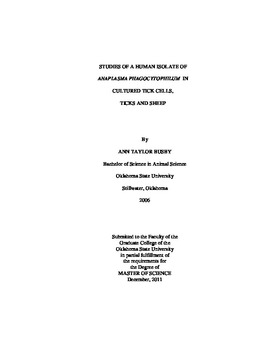| dc.contributor.advisor | Kocan, Katherine M. | |
| dc.contributor.author | Busby, Ann Taylor | |
| dc.date.accessioned | 2014-04-16T03:15:49Z | |
| dc.date.available | 2014-04-16T03:15:49Z | |
| dc.date.issued | 2011-12-01 | |
| dc.identifier.uri | https://hdl.handle.net/11244/9808 | |
| dc.description.abstract | The proteome of the Ixodes scapularis-derived cell line, ISE6, was characterized after infection with the tick-borne pathogen, Anaplasma phagocytophilum. Proteomics were used to identify proteins differentially expressed in cultured tick cells in response to Anaplasma phagocytophilum and these results were correlated with mRNA levels by real-time RT-PCR. RNA interference (RNAi) was then used to characterize the function of genes found to be differentially expressed in the infected cells. In the second portion of the research a sheep/tick/A. phagocytophilum model was developed in order to study tick/pathogen interactions of the human NY-18 isolate of A. phagocytophilum and I. scapularis. A. phagocytophilum was propagated in the human promyelocytic cell line, HL-60, and the infected cell cultures were then used as an inoculum for infection of sheep by intravenous inoculation. After the sheep were shown by PCR to be infected, ticks were allowed to feed on the sheep and acquire A. phagocytophilum infection. Tick infection dynamics were then characterized by PCR. The proteomic analysis of cultured ISE6 cells after A. phagocytophilum infection demonstrated that expression of proteins involved in cell growth and transport was significantly reduced, thus reflecting the effect of pathogen multiplication on these cell processes. New genes were identified, including spectrin alpha chain or alpha-fodrin and Voltage-dependent anion-selective channel or mitochondrial porin, to be involved in tick cell infection/multiplication of A. phagocytophilum, thus contributing to our understanding of the molecular events at the tick-pathogen interface. In the sheep model study, female I. scapularis acquired infection on each of the three experimentally-infected sheep as determined by PCR of tick guts (80 to 87%) and salivary glands (67 to 100%). Transstadial transmission was confirmed 14 days after female I. scapularis, infected as nymphs, transmitted A. phagocytophilum to a susceptible one. The results from this research demonstrated that sheep are a good host for infection of I. scapularis ticks with the human NY-18 isolate of A. phagocytophilum. The results of this research have contributed to our understanding of the tick/A. phagocytophilum interface and will likely contribute towards the development of novel tick control measures. | |
| dc.format | application/pdf | |
| dc.language | en_US | |
| dc.publisher | Oklahoma State University | |
| dc.rights | Copyright is held by the author who has granted the Oklahoma State University Library the non-exclusive right to share this material in its institutional repository. Contact Digital Library Services at lib-dls@okstate.edu or 405-744-9161 for the permission policy on the use, reproduction or distribution of this material. | |
| dc.title | Studies of a Human Isolate of Anaplasma Phagocytophilum in Cultured Tick Cells, Ticks, and Sheep. | |
| dc.type | text | |
| dc.contributor.committeeMember | Fuente, Jose de la | |
| dc.contributor.committeeMember | Blouin, Edmour | |
| osu.filename | Busby_okstate_0664M_11802.pdf | |
| osu.college | Center for Veterinary Health Sciences | |
| osu.accesstype | Open Access | |
| dc.description.department | Veterinary Pathobiology | |
| dc.type.genre | Thesis | |
| dc.subject.keywords | veterinary medicine | |
| dc.subject.keywords | parasitology | |
